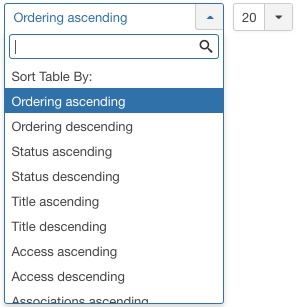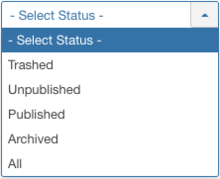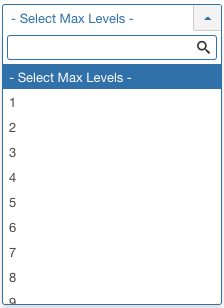Users User Note Categories/id
From Joomla! Documentation
Description
This screen allows you to look at a list of your user note categories and sort them in different ways. You can also edit and create user note categories and access levels.
How to access
You can access the Notes Category Manager by clicking on Users → User Note Categories or clicking User Note Categories link in the Users Manager Menu in the left sidebar when an other User Manager page is displayed.
Screenshot
Column Headers
In the table containing the user note categories from your Joomla! site, you will see different columns.
- Ordering. Up-Down Arrows
 . User specified ordering, default is order of item creation. When active, drag and drop ordering by 'click and hold' on the bars icon
. User specified ordering, default is order of item creation. When active, drag and drop ordering by 'click and hold' on the bars icon then 'release' in desired position.
then 'release' in desired position.
- Checkbox. Check this box to select one or more items. To select all items, check the box in the column heading. Note: Many toolbar actions can work with multiple items.
- Status. (Publish/Unpublish/Trash) The published status of the item.
- Title. The name of the item. You can open the item for editing by clicking on the Title.
- Access. The viewing Access Level for this item. You can change an item's Access Level by clicking on its Title to open it up for editing.
- Language. Item's language. If you are not using the multi-language feature of Joomla, default is 'All'.
- ID. This is a unique identification number for this item assigned automatically by Joomla. It is used to identify the item internally, and you cannot change this number.
Column Filters
Above the column headers on the right, there are 2 dropdown input fields, Sort Table By: (preset to 'Ordering ascending') and a number (preset to '20') to display.
These column sorting input fields shows the current method of sorting applied to the table. Use the dropdown field choices and click the column heading name. Alternatively, click on the column heading to sort the list by that column's value.
This will also change the value in the drop field to correspond with the column header name. The list will then be sorted in order by that column and a sort icon (up or down arrow) will show next to the column name. Click a second time to reverse the sort, which will change the corresponding drop field.
- Order (default). Shows ordering of selected column, ascending or descending.
This page is a candidate for deletion. The given reason is: No links here.
This notice should remain for a minimum of 1 week after it was placed on the page. If discussion is still ongoing, it should remain until a consensus is reached, after which the page will either be deleted or this notice removed. If you disagree with its deletion, please discuss your reasons on its associated talk page, as applicable.
Remember to check if anything links here and the page history before deleting.
Last edit by FuzzyBot (talk · contrib) · Last edited on Wed, 01 Apr 2020 06:27:21 +0000
- Ascending Shows ordering of selected column, ascending or descending.
- Number of items to display. Shows the number of items to display on one page, default is 20 items. If there are more items than this number, you can use the page navigation buttons to navigate between pages.
List Filters
The List Filter, above on the left, and other filters, left, bottom sidebar are a series of controls that let you limit what items show in the user note category manager screen. More than one filter may be entered. Only items that meet all of the filter conditions will show on the list.
Filter by Partial Title or ID
In the upper left is a search field and 2 buttons.
- To filter by partial title, enter part of the title and click 'Search'

- To filter by ID number, enter "id:xx", where "xx" is the ID number (for example, "id:29").
- Click 'Clear' to clear the Filter field and restore the list to its unfiltered state.
Filter by Status
Lets you show only items with the selected published status.
- - Select Status -: Show only items that are Published and Unpublished.
- Trashed: Show only items that are Trashed. Quick Tip: Permanently delete items
- Unpublished: Show only items that are Unpublished.
- Published: Show only items that are Published.
- Archived: Show only items that are Archived.
- All: Show all items regardless of published status.
Filter by Access
Lets you show only items that have a specified viewing access level. The list box will show the access levels defined for your site.
- - Select Access -: Show items with any viewing access level.
- Public: Show only items with this viewing access level.
- Guest: Show only items with this viewing access level.
- Registered: Show only items with this viewing access level.
- Special: Show only items with this viewing access level.
- Super Users: Show only items with this viewing access level.
Filter by Language
Lets you show only items that have a specific language assigned. The list box will show the languages defined for your site.
- - Select Language -: Show items for any language.
- All: Show items set for 'All' languages.
- English (en-GB): Show items only for this language.
Filter by Tag
Lets you show only items that have a specified tag. The list box will show the tags created for your site.
- - Select Tag -: Show items with any (or no) tag(s).
- Joomla: Show only items with this tag.
Filter by Max Levels (Item Level)
Lets you show only items at or above the specified level in the hierarchy.
- - Select Max Levels -: Show all items.
- 1: Show only items at the top level in the hierarchy (in other words, whose parent is '- No Parent -').
- 2: Show only items in the top and 2nd levels in the hierarchy.
- 3: Show only items in the top, 2nd and 3rd levels in the hierarchy.
- 4 … 8
- 9: Show only items in the top, 2, 3, 4, 5, 6, 7, 8 and 9 levels in the hierarchy.
- 10: Show only items in 10 levels in the hierarchy.
Page Controls. When the number of items is more than one page, you will see a page control bar as shown below. The current page number being viewed is shaded.
- Start: Click to go to the first page.
- Prev: Click to go to the previous page.
- Page numbers: Click to go to the desired page.
- Next: Click to go to the next page.
- End: Click to go to the last page.
Toolbar
At the top you will see the toolbar:
The functions are:
- New. Opens the editing screen to create a new category.
- Edit. Opens the editing screen for the selected category. If more than one category is selected (where applicable), only the first category will be opened. The editing screen can also be opened by clicking on the Name of the category.
- Publish. Makes the selected user notes category available to administrators of your website.
- Unpublish. Makes the selected user notes category not available to administrators of your website.
- Archive. Changes the status of the selected category to indicate that they are archived. Archived category can be moved back to the published or unpublished state by selecting "Archived" in the Select Status filter and changing the status of the category to Published or Unpublished as preferred.
- Check-in. Checks-in the selected category. Works with one or multiple category selected.
- Batch. Batch processes the selected category. Works with one or multiple items selected.
- Rebuild. Reconstructs and refreshes the relevant table. Normally, you do not need to rebuild this table. This function is provided in case the data in the table becomes corrupted.
- Trash. Changes the status of the selected category to indicate that they are trashed. Trashed category can still be recovered by selecting 'Trashed' in the 'Select Status' filter and changing the status of the category to Published or Unpublished as preferred. To permanently delete trashed category, select 'Trashed' in the 'Select Status' filter, select the category to be permanently deleted, then click the 'Empty Trash' toolbar icon.
- Help. Opens this help screen.
- Options. Opens the Options window where settings such as default parameters can be edited.
Batch Process
This page is a candidate for deletion. The given reason is: No links here.
This notice should remain for a minimum of 1 week after it was placed on the page. If discussion is still ongoing, it should remain until a consensus is reached, after which the page will either be deleted or this notice removed. If you disagree with its deletion, please discuss your reasons on its associated talk page, as applicable.
Remember to check if anything links here and the page history before deleting.
Last edit by FuzzyBot (talk · contrib) · Last edited on Wed, 01 Apr 2020 06:27:21 +0000






